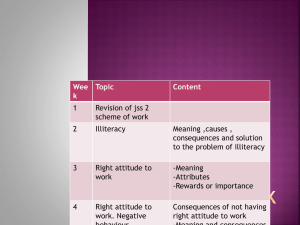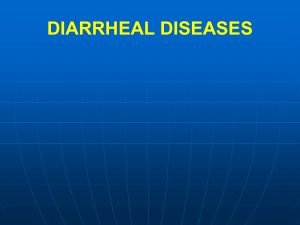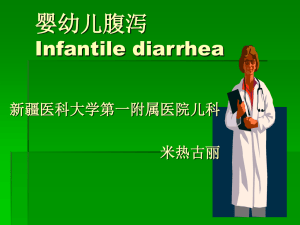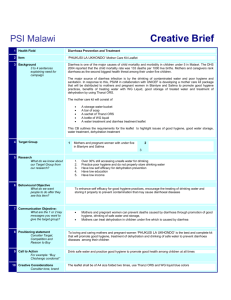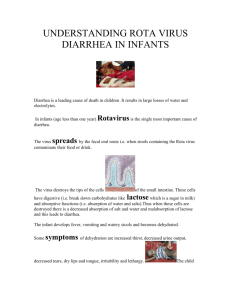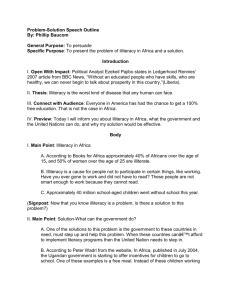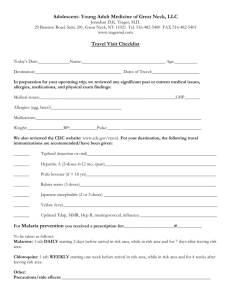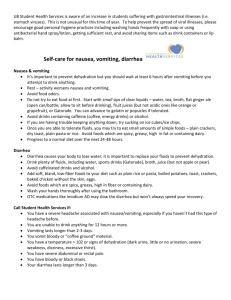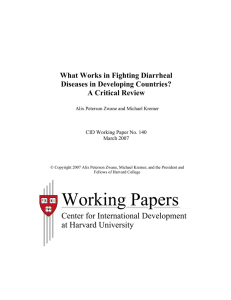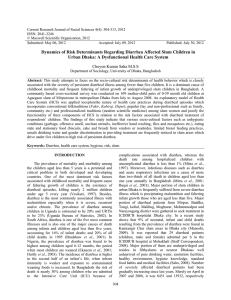Concepts in Public Health: A Case Study of Diarrhea
advertisement
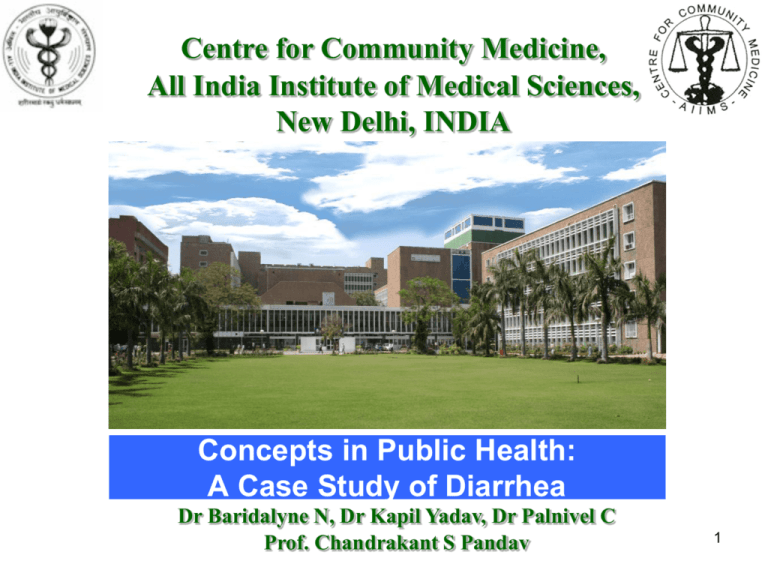
Centre for Community Medicine, All India Institute of Medical Sciences, New Delhi, INDIA Concepts in Public Health: A Case Study of Diarrhea Dr Baridalyne N, Dr Kapil Yadav, Dr Palnivel C Prof. Chandrakant S Pandav 1 Babita, Age – 2 years The Story……………. • Baby girl aged 2 yrs • Large family -5 siblings • Diarrhea & Dehydration • Grandmother told not to feed child during diarrhea • No health facility in village • Couldn’t go in the night –had to look after other children & drunken husband • Mother walks to nearby hospital-10 kms away! • Unfortunately the girl child dies 3 Causes of death among children under five years of age in India 4 Source- WHO- India: Mortality Country Fact Sheet 2006 Burden of Diarrheal Diseases in India • 9.1% of all deaths below 6 years¹ • 158,209 diarrheal deaths per year¹ • 2 week prevalence- 12.2% in children < 3 years² • 10.5 episodes per child per year ³ 1- National Commission on Macroeconomics and Health, 2005. 2- National Family Health Survey 3 (2005-06) 3- Bhattacharya SK, 2003. NMJI, 16 (S 2): 15-19. 5 What were the factors that led to Babita’s death? 6 What were the factors that led to Babita’s death? Many siblings No family support Poor hygiene No transport Lack of care No medical facility Wrong Cultural beliefs & practices Diarrhea Dehydration Female child Poverty Malnutrition < 2 yrs old Illiteracy 7 Web of Causation 8 No family support Many siblings Wrong Cultural beliefs And practices Lack of care Female child Poor hygiene No medical facility Diarrhea Dehydration No transport Malnutrition Low socio economic status Illiteracy 9 Was the death preventable? YES No family support Wrong Cultural Beliefs & practices Many siblings Lack of care Female child Poor hygiene No transport No medical facility Diarrhea Dehydration Malnutrition Poverty Illiteracy 11 No family support Wrong Cultural Beliefs & practices Many siblings Lack of care Female child Poor hygiene No medical facility Diarrhea Dehydration Poverty Malnutrition Illiteracy THROUGH THE THE HEALTH SYSTEM THROUGH HEALTH SYSTEM 12 No family support Faulty advice Many siblings Lack of care No medical facility Poor hygiene No transport No medical facility Diarrhea Dehydration Poverty Malnutrition Illiteracy OUTSIDE THE HEALTH SYSTEM 13 Concepts of disease causation • Traditional Bio-medical concept – Disease caused due to the presence of causative agents – Basis in Germ theory of disease • Socio- Epidemiological Concept – Causative agents alone may/may not be sufficient for disease occurrence – Social factors important in the disease causation & progression • Politico- Developmental Concept – Comprehensive approach, puts health in the context of various politico- developmental situations – Effects of government policies & outfalls of development on disease occurrence, 14 – Stems from the multi-factorial causation of disease Traditional Bio-Medical Concept VIBRIO E. COLI (Entero Pathogenic) CHOLERA E. COLI (Entero Toxigenic) SHIGELLA DIARRHEAL DISEASES CRYPTOSPORIDIUM ROTA VIRUS CAMPYLOBACTER SALMONELLA 15 Socio- Epidemiological Concept & ILLITERACY 16 Politico- Developmental Concept & ILLITERACY 17 Public health trains you to have a “Holistic Approach” to Health and Disease 19 20 Clinical Vs Public Health Variables Clinical Medicine Public health UNIT OF STUDY • Individual • Population TARGET GROUP • Patient – with disease • Diseased/NonDiseased VIEWPOINT OF HEALTH SYSTEM TYPE OF CARE SERVICE PROVIDERS BENEFITS •Passive process • Active process • Focus on curative • Comprehensive care • Provided by private sector • Provided by PUBLIC/private sector • Short term benefits • Obvious benefit • Long term benefits • Not obvious In Public Health – Good work means no epidemics 21 Axioms of Public Health • Prevention is better than cure • Best should not be the enemy of good • Good for many rather than best for few • Primary health care is NOT primitive care 22 23 Bhore Committee • “The physician of tomorrow, • who will naturally be concerned • with the promotion of the new era of social medicine- • will be scientist and social worker, • ready to cooperate in team work,, • in close touch with the people he serves, • a friend and leader, • he directs all his efforts towards the prevention of disease, and • becomes a therapist where prevention has broken down, • the social physician, • Protecting the people, and • Guiding them to a healthier and happier life”. -BHORE COMMITTEE REPORT (1946) 24 -Health Survey & Development Committee , Government of India Critical appraisal Yes Can’t tell No Do you believe the results? Can the results be applied to the local population? Do the results of this study fit with other available evidence? Thank You 25/59
